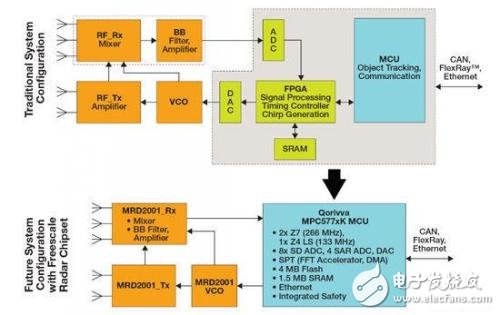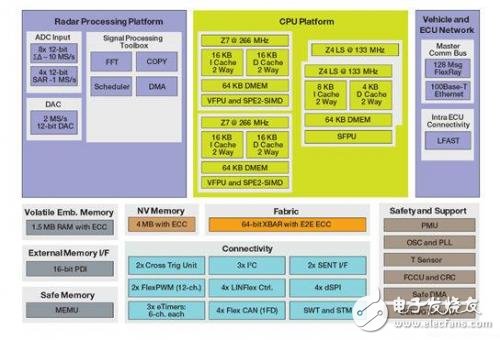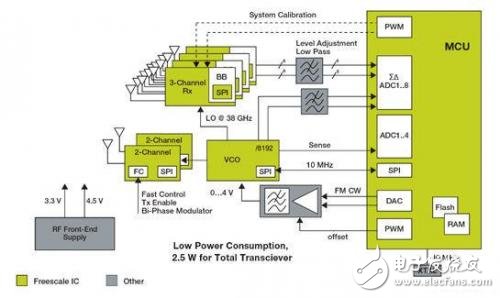At present, the number of deaths caused by road traffic accidents around the world continues to rise. According to the World Health Organization, in 2010, 1.24 million people died in road traffic accidents, and traffic accidents have become the leading cause of accidental deaths among the eighth largest person in the world. In developed regions, passive safety systems, safety belts, airbags, and impact buffers have become the basic configuration and measures to reduce the deaths and serious damages of car owners and pedestrians. But even in some developed regions of the world where vehicles are becoming more interconnected and providing vehicle operators with ever-increasing levels of information, analysts still believe that driver distraction is causing death and seriousness The real potential for damage to the accident, car manufacturers need to improve the vehicle's automatic safety system, and this demand is increasing year by year.
On the other hand, when the global automotive industry is working towards the goal of “zero mortality†for vehicle accidents, consumer demand and government legislation are also driving improvements in automotive safety standards, active and predictive anti-collision safety systems in Hyundai. It is becoming more and more popular. For example, the value-added features of Advanced Driver Assistance Systems (ADAS)—electronic stability control systems and rear-view cameras, as well as vision-based pedestrian detection systems—are becoming possible with advances in microcontroller and sensor technology. In addition, enhanced embedded solutions based on radar technology can provide complementary security features for ADAS designers.
New radar technology solution
With the recent introduction of standards and regulations in various countries around the world, more and more ADAS systems are expected to become mandatory vehicle installation systems in the future, such as rear view cameras for vehicles and advanced emergency brake assist systems for commercial vehicles. AEBS) and so on. Radar-based automotive safety systems enable blind spot and side collision detection, as well as front-range radar detection at medium and long distances to achieve adaptive cruise control.
Take, for example, an embedded microcontroller from Freescale and a 77 GHz millimeter-wave integrated circuit for radar applications. The typical radar module consists of a transmit solution (Tx), a voltage controlled oscillator (VCO), and a three-channel receiver IC. (Rx) and microcontroller (MCU) components. The chip is connected via a local oscillator (LO) signal of approximately 38 GHz, and each chip can be independently controlled via the Serial Peripheral Interface (SPI) bus. The main controller and modulation master is a single microcontroller with integrated high-speed analog-to-digital converters (ADCs) with appropriate signal processing functions such as Fast Fourier Transform (FFT).
With the Qorivva MPC577xK MCU and the MRD2001 77GHz radar transceiver chipset, Freescale has introduced a new generation of embedded radar-based products. The radar transceiver chipset consists of a VCO (MRD2001VC), a 2-channel Tx transmitter (MRD2001TX) and a 3-channel RX receiver (MRD2001RX). These new products provide a complete embedded radar system for automotive design. At the same time, the radar technology solution complements existing high-performance ADAS systems, for example, in embedded camera/video products – Freescale SCP220x Image Cognitive Processor (ICP) series and Qorivva MPC5604E MCU – Designed for advanced vision processing for vehicle and pedestrian inspection to meet automotive manufacturers' higher performance requirements for ADAS solutions.
Advanced system integration performance
Many current radar systems are based on the Qorivva MPC5675K MCU - including external FPGAs, ADCs, DACs, SRAMs, and analog front ends for transmit and receive. The new MPC577xK MCUs support cost-effective radar systems in a single-chip solution while further enhancing system performance.
The MPC577xK family offers a high level of digital and analog integration in a single 356 BGA package, eliminating the need for external FPGAs, ADCs, DACs, and SRAMs for a cost advantage, reducing the number of components required, PCB size, and software complexity.

Figure 1: Evolution of the radar chipset
In addition to the two 266 MHz e200z7 processing cores, the MPC577xK MCU also features a state-of-the-art Signal Processing Toolbox (SPT) that contains the hardware blocks needed to process sampled signals for short, medium and long range radar applications. SPT is a powerful processing engine that drives high-performance signal processing operations with a specific command-driven instruction set. Its programmability ensures flexibility when controlling CPU removal during frequent hardware task scheduling, controlling process flow and interacting with it. System benefits include: easy-to-use MCU with integrated FFT accelerator; high-density memory for scalable radar applications; open-loop and phase-locked loop systems for design flexibility; and controllable power consumption for improved Efficiency; helps system manufacturers meet functional safety ISO 26262 ASIL-D goals.
In terms of safety features, the MCP577xK MCU features two high-performance Power Architecture e200z7 cores for signal processing and helps automakers achieve the lowest ISO 26262 automotive safety integrity level -B (as part of the Freescale SafeAssure project). ASIL-B). In addition to meeting the requirements of automotive functional safety applications, the lockstep configuration uses two e200z4 cores designed to meet decision-making and critical safety requirements to help achieve ISO 26262 ASIL-D certification.
In addition, the MCP577xK MCU has several other key security features such as Online Logic Built-In Self Test (LBIST), Memory Built-In Self Test (MBIST), End-to-End Error Correction Code (ECC), Clock and Generation Monitor, and Fault Handling Module. Etc., can help customers get ASIL-D certification.

Figure 2: Qorivva MPC577xK MCU Block Diagram
High performance and expandable to multiple channels
The MRD2001 77GHz Radar Transceiver Chipset is a scalable, high performance triple package solution for automotive radar modules. The chipset consists of a VCO, a 2-channel Tx transmitter and a 3-channel RX receiver. All three are in a 500um pitch, 6mm x 6mm fan-out wafer level package. This packaging technology is ideal for 77 GHz radar applications due to its extremely low insertion loss and parasitic effects at frequencies up to 100 GHz. In addition, the packaged chipset simplifies end-user radar module assembly by eliminating the need for chip and wiring assembly techniques for the die. The chipset can be extended to four TX channels and 12 RX channels at any time, enabling a single radar platform to control the beam in a wide field of view, supporting long-range, mid-range and short-range radar applications in low, medium and high-end luxury vehicles.
At the same time, the system can be extended to 4 TX channels and 12 RX channels, all with active channels, enabling individual platforms to achieve beam control over a wider detection area; advanced packaging technology ensures maximum performance on the user's PCB And lowest signal interference; low power, full-featured transceiver typically consumes 2.5W; supports fast modulation of 100MHz/100ns; with optimal phase noise of less than -93dBc/Hz at 1MHz offset for improved Target separation; integrated baseband filter and VGA save system material cost; 38GHz local oscillator reduces circuit losses and reduces system interference; the two-phase modulator on the transmitter chip rejects spurious signals.
The MRD2001 Radar Transceiver Chipset uses advanced packaging technology to provide superior thermal and electrical performance. The package meets stringent automotive standards, including solder joint reliability, deep temperature and humidity cycling, and EMC performance, and is available to major suppliers for compliance with Reducing Hazardous Substances (RoHS) standards.

Figure 3: MRD2001 77 GHz Radar Transceiver Chipset
Support for open loop radar system design
The MPC577xK MCU and MRD2001 77GHz radar transceiver chipset are specifically designed to support open-loop radar systems. In this system, the phase-locked loop does not need to generate a chirp signal (FMCW modulation), thus reducing the total power consumption of the system.
The open-loop concept is generally used in conjunction with fast chirped signal FMCW modulation with a frequency modulation time in the range of 10us to 100us. Since the complete radar image can be captured more quickly, the fast chirp signal system can reduce the duty cycle and improve the SNR of the radar system. The potential disadvantage of high baseband frequency is that it will drive the required ADC with higher analog bandwidth and Sampling Rate. The MPC577xK MCU overcomes this potential problem because it integrates up to eight ADCs with a 5MHz bandwidth and an internal sampling clock of 320 MHz.
In an open-loop radar system, the MCU is a linear FM signal master with a digital-to-analog converter (DAC) that provides the tuning voltage for the VCO. Depending on the tuning voltage, the VCO can generate a high frequency signal (LO) that drives different receiver and transmitter chips.
During normal operation, the system transmits a chirp signal and receives a reflected signal. The receiver combined with the transmitter acts as a homodyne system, and the received signal is directly down-converted into the baseband. The baseband signal is then filtered and amplified (the receiver chip contains the filter and variable gain amplifier) ​​and delivered to the -ADC of the MPC577xK MCU. By transforming the baseband signal into a digital domain, using a digital beamforming method, employing FFT and tracking algorithms, the target can be identified based on distance, velocity, and angular position.
to sum up
As global mainstream automakers increase demand for active and predictive security systems, semiconductor suppliers need to innovate. The new solution must enable system vendors and OEMs not only to optimize the cost of materials for today's radar systems based on cost, but also on specifications. In addition to the long-range forward radar, manufacturers also need to combine radar systems that detect blind spots and side collisions. The latest radar-based solutions will provide unique functional support for developers of next-generation ADAS systems, helping them not only meet the latest industry regulatory standards, but also better protect their lives and property.
We have experience and skill to support customers to tooling for their required waterproof connectors, like IP68 series,micro fit connectors. Etop wire assemblies for various industries have been highly recognized by all the customers and widely used for automobiles, electrical and mechanical, medical industry and electrical equipemnts, etc. Products like, wire harness for car audio, power seat, rear-view mirror, POS ATM, Diesel valve Cover gasket fit, elevator, game machine, medical equipment, computer, etc.
JST Connector,Molex Connector, Multi-Contact Connector, Micro Fit Connectors
ETOP WIREHARNESS LIMITED , https://www.oemwireharness.com